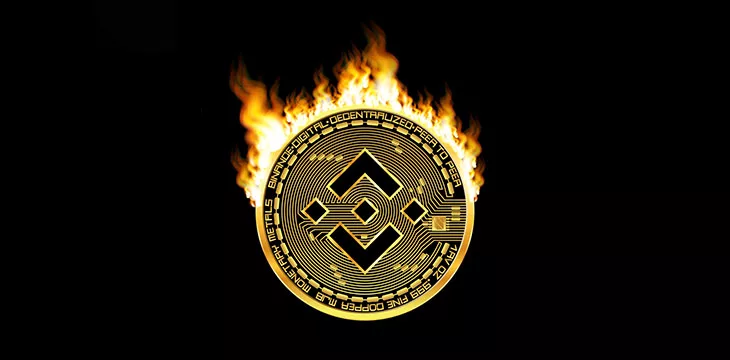|
Getting your Trinity Audio player ready...
|
Binance’s ties to terror groups appear greater than initially advertised, while the controversial digital asset exchange is facing shrinking volume and further limits on its U.S. and U.K. operations.
On Tuesday, the Financial Times reported that Israeli authorities had compelled the freezing of over 100 Binance customer accounts linked to Hamas since the terror group launched its attack against Israel on October 7. The FT noted that these accounts contained “millions of dollars” worth of tokens, and Israel is seeking further information on around 200 other suspect accounts, most of which are said to be on Binance.
Despite these figures, a Binance spokesperson downplayed the reports, saying the exchange had only blocked a “small number of accounts linked to illicit funds.” But the FT quoted an unidentified Binance staffer who said the exchange had been instructed to “go back and find all the Binance customers that have had exposure” to blockchain addresses linked to Hamas fundraising efforts.
These new details flesh out previous reports of Israeli authorities pressuring Binance to step up its terror funding mitigation efforts. Binance has a proven track record of lax know-your-customer (KYC) and anti-money laundering (AML) practices that have made it a hub for criminals of all stripes looking to move cash outside traditional financial channels.
Since 2019, when Hamas began seriously exploring ‘crypto’ financing options, Binance has featured prominently in Israeli reports of Hamas receiving tens of millions of dollars worth of digital assets—primarily USDT (Tether) and other stablecoins—from sympathetic donors. That total skyrockets once you factor in other Islamic terror groups, including the Lebanon-based Hezbollah, which may yet join the current turmoil.
Binance isn’t the only ‘crypto’ operator the Israeli authorities are leaning on. Tether announced Monday that it had frozen 32 addresses “linked to illicit activity in Israel and Ukraine” as part of its efforts to “counter cryptocurrency-funded terrorism and warfare.” However, Israeli authorities have so far failed to offer their version of these events, opening up the possibility that Tether was just trying to front-run more embarrassing news coming down the pike.
While early reports indicated that Hamas hadn’t yet experienced a surge in fresh ‘crypto’ donations, Israel National Cyber Directorate exec director Tom Alexandrovich told the FT that digital asset donations to Hamas “have super-increased since the attack began.”
Binance likes to claim that it’s leading the charge in combating terror financing, but leaked internal communications of senior Binance execs have exposed the exchange’s utter disinterest in policing its customers’ activities, even customers known to be affiliated with Hamas.
Binance’s abrogation of oversight—and the prioritization of profit above all other concerns, even human life—will prove an aggravating factor when the U.S. Department of Justice (DOJ) finally lowers the boom on founder Changpeng ‘CZ’ Zhao for money laundering, sanctions evasion, or any number of other possibilities.
No more Binance.US(D)
Stateside, Binance is still wrestling with civil suits filed by both the Securities and Exchange Commission (SEC) and the Commodity Futures Trading Commission (CFTC). Since those suits were filed, the company’s U.S.-licensed exchange, Binance.US, has seen its site traffic and trading volume fall off a cliff, and its operations took yet another hit on Monday.
Binance.US updated its terms of service to confirm that customers who still hold U.S. dollars in their exchange accounts will no longer be able to withdraw them to a bank. Effective Monday (October 16), withdrawals can only be conducted by converting USD to “stablecoins or other digital assets” and then withdrawing those assets to a digital wallet. After that, you’re on your own to findind a way to convert to hard cash.
The shift wasn’t entirely unexpected, as Binance.US suspended USD deposits in June as the civil suits and talk of pending criminal charges convinced most banks they wanted nothing to do with this crime scene.
Binance.US also warned customers that their “accounts and digital assets are no longer eligible for FDIC insurance protections.” This change was made “in accordance with guidance received” from the Federal Deposit Insurance Corporation. Binance.US previously earned a rebuke from the FDIC for promoting its customers’ USD deposits as “insured by the FDIC.” So not only are the accounts ‘no longer eligible’ for FDIC insurance, they never were. (Even now, Binance can’t stop lying.)
Multiple ‘crypto’ companies employed similar subterfuge, forcing the FDIC to start pushing back on these erroneous claims over a year ago. Last week, the Federal Trade Commission (FTC) and CFTC filed civil suits against Stephen Ehrlich, ex-CEO of bankrupt digital asset lender Voyager Digital, for a number of offenses, including claims that Voyager customers were covered by FDIC insurance.
The FCA is not amused
Across the pond, Binance said Monday it was halting the onboarding of new U.K. customers to comply with new Financial Conduct Authority (FCA) rules regarding digital asset firms’ interactions with U.K. residents. Among these rules is a stipulation that digital asset companies lacking an FCA license can’t market their wares to U.K. customers unless their promotional material is approved by an FCA-licensed entity.
Seeking to take full advantage of this loophole, Binance partnered with FCA-licensed Rebuildingsociety.com Ltd (REBS), a peer-to-peer lending platform. But the FCA announced last week that it was imposing new restrictions on REBS “to restrict it from approving cryptoasset financial promotions.”
The FCA said it was exercising its powers under the Financial Services and Markets Act to “impose requirements on a firm in circumstances where [the FCA] concludes that it is necessary to do so to advance one or more of the FCA’s operational objectives, which includes securing an appropriate degree of consumer protection.” REBS was given the right to make representations to the FCA regarding these restrictions and to refer the matter to the Upper Tribunal, but it seems Binance isn’t willing to wait around.
Binance said Monday that it was on the hunt for “another suitable FCA authorized firm to approve our financial promotions as soon as possible.” The trouble is, the FCA can probably keep this up as long as Binance can, given the regulator’s previous public warnings about Binance’s repeated efforts to ‘backdoor’ its way into the U.K. market. In March 2002, the frustrated FCA stated that Binance was “not capable of being effectively supervised.”
As with so many other markets, Binance has squandered multiple opportunities to comply with local rules and regulations, choosing instead to publicly declare their intention to do what’s required, then going right back to acting as if they’re above the law. Remember that the next time Binance says something about how diligently they’re rooting out terror groups from their ecosystem.
Circling the drain
There’s no question that Binance is currently under significant stress, a fate shared by most exchanges as retail traders continue to treat ‘crypto’ as a fleeting fad that hasn’t been cool since 2021.
New research by blockchain sleuth Colin Wu shows that Binance’s overall traffic numbers fell by 18.5% from August to September. As bad as that is, remember that this was before Binance pretended to exit the Russian market, its top source of traffic. (Further evidence that this exit was yet another head-fake came Tuesday.)
Over the same period, Binance’s spot trading volume fell by 30% while futures volume was down 20%. Binance remains the clear leader in both spot and futures, but it also ranked in the top three biggest decliners in both categories, reflecting overall market lows not seen since October 2020.
Binance’s volume might be on the decline, but one thing’s for sure: it’s not the FDUSD stablecoin’s fault. Since its debut in July, FDUSD has been Binance’s top tool for frenetic wash-trades intended on propping up BTC’s fiat price. FDUSD-BTC remains the top trading pair on Binance, accounting for nearly one-quarter of its overall volume.
It didn’t hurt that FDUSD’s market cap grew by another $60 million last week to a new high of $468 million, while FDUSD’s 24-hour trading volume—all but a minute fraction of which occurs on Binance, likely via CZ’s 300-odd ‘house accounts’—continues to clock in around 4x that sum. Suffice it to say, Binance is not the hot party you think it is. And it probably never was.
Follow CoinGeek’s Crypto Crime Cartel series, which delves into the stream of group—from BitMEX to Binance, Bitcoin.com, Blockstream, ShapeShift, Coinbase, Ripple,
Ethereum, FTX and Tether—who have co-opted the digital asset revolution and turned the industry into a minefield for naïve (and even experienced) players in the market.

 05-06-2025
05-06-2025 





